Bichop R.H. (Ed.) Mechatronic Systems, Sensors, and Actuators: Fundamentals and Modeling
Подождите немного. Документ загружается.

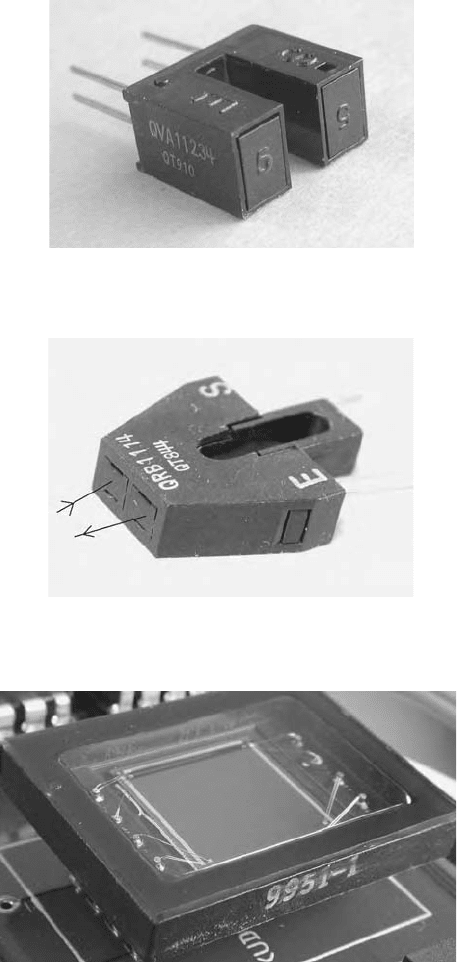
20-4 Mechatronic Systems, Sensors, and Actuators
Photointerrupters and photoreflectors can be bought prepackaged or constructed separately from an
infrared LED and a photodiode or phototransistor, after making certain the detector is sensitive to the
wavelength produced by the LED.
Photoreflector units are also available with more advanced position sensitive detectors (PSDs), which
report the location of infrared light incident on the sensing surface (Figure 20.7). The fixed location of the
LED relative to the PSD, as well as the location of the image of the infrared light on the PSD, allows the
FIGURE 20.5 The Fairchild semiconductor QVA11234 photointerrupter.
FIGURE 20.6 The Fairchild semiconductor QRB1114 photoreflective sensor.
FIGURE 20.7 A position sensitive detector, UDT Sensors, Inc.
9258_C020.fm Page 4 Tuesday, October 9, 2007 9:08 PM
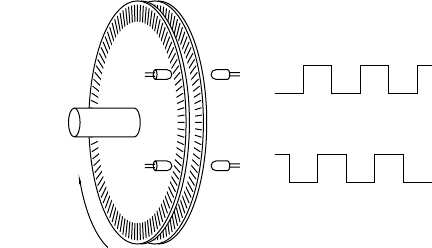
Sensors 20-5
use of triangulation to determine the distance to the target. Such distance measuring sensors are manufac-
tured by Sharp and Hamamatsu.
20.1.2.1 Optical Encoders
An optical encoder uses photointerrupters to convert motion into an electrical pulse train. These electrical
pulses “encode” the motion, and the pulses are counted or “decoded” by circuitry to produce the displace-
ment measurement. The motion may be either linear or rotational, but we focus on more common rotary
optical encoders.
There are two basic configurations for rotary optical encoders, the incremental encoder and the absolute
encoder. In an incremental encoder, a disk (or codewheel) attached to a rotating shaft spins between two
photointerrupters (Figure 20.8). The disk has a radial pattern of lines, deposited on a clear plastic or
glass disk or cut out of an opaque disk, so that as the disk spins, the radial lines alternately pass and
block the infrared light to the photodetectors. (Typically there is also a stationary mask, with the same
pattern as the rotating codewheel, in the light path from the emitters to the detectors.) This results in
pulse trains from each of the photodetectors at a frequency proportional to the angular velocity of the
disk. These signals are labeled A and B, and they are 1/4 cycle out of phase with each other. The signals
may come from photointerrupters aligned with two separate tracks of lines at different radii on the disk,
or they may be generated by the same track, with the photointerrupters placed relative to each other to
give out of phase pulse trains.
By counting the number of pulses and knowing the number of radial lines in the disk, the rotation of
the shaft can be measured. The direction of rotation is determined by the phase relationship of the A
and B pulse trains, that is, which signal leads the other. For example, a rising edge of A while B = 1 may
indicate counterclockwise rotation, while a rising edge of A while B = 0 indicates clockwise rotation. The
two out-of-phase signals are known as quadrature signals.
Incremental encoders commonly have a third output signal called the index signal, labeled I or Z. The
index signal is derived from a separate track yielding a single pulse per revolution of the disk, providing
a home signal for absolute orientation. In practice, multiple photointerrupters can be replaced by a single
source and a single array detecting device.
IC decoder chips are available to decode the pulse trains. The inputs to the chip are the A and B signals,
and the outputs are one or more pulse trains to be fed into a counter chip. For example, the US Digital
LS7083 outputs two pulse trains, one each for clockwise and counterclockwise rotation, which can be
sent to the inputs of a 74193 counter chip (Figure 20.9). Standard decoding methods for the quadrature
input are 1X, 2X, and 4X resolution. In 1X resolution, a single count is generated for the rising or falling
edge of just one of the pulse trains, so that the total number of encoder counts for a single revolution
of the disk is equal to the number of lines in the disk. In 4X resolution, a count is generated for each
rising and falling edge of both pulse trains, resulting in four times the angular resolution. An encoder
FIGURE 20.8 Schematic of an incremental encoder.
A
B
Shaft
Rotating
codewheel
Stationary
mask
9258_C020.fm Page 5 Tuesday, October 9, 2007 9:08 PM
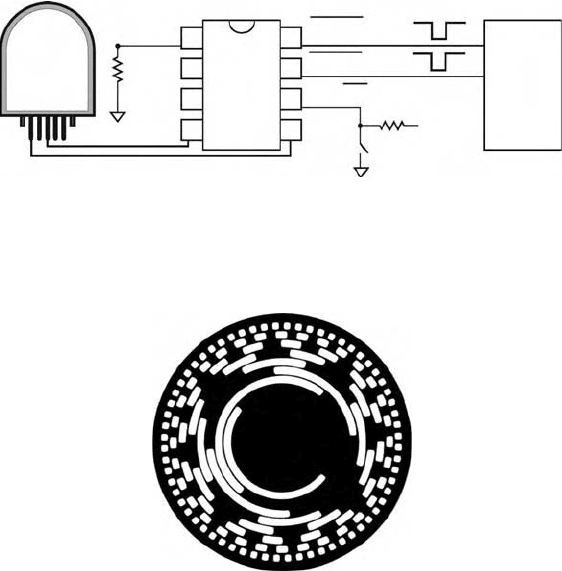
20-6 Mechatronic Systems, Sensors, and Actuators
with 1000 lines on the code wheel being decoded at 4X resolution yields an angular resolution of 360°/
(4 × 1000) = 0.09°.
While a single-ended output encoder provides the signals A, B, and possibly Z, a differential output
encoder also provides the complementary outputs A′, B′, and Z′. Differential outputs, when used with
a differential receiver, can increase the electrical noise immunity of the encoder.
A drawback of the incremental encoder is that there is no way to know the absolute position of the
shaft at power-up without rotating it until the index pulse is received. Also, if pulses are momentarily
garbled due to electrical noise, the estimate of the shaft rotation is lost until the index pulse is received.
A solution to these problems is the absolute encoder. An absolute encoder uses k photointerrupters and
k code tracks to produce a k-bit binary word uniquely representing 2
k
different orientations of the disk,
giving an angular resolution of 360°/2
k
(Figure 20.10). Unlike an incremental encoder, an absolute encoder
always reports the absolute angle of the encoder.
The radial patterns on the tracks are arranged so that as the encoder rotates in one direction, the
binary word increments or decrements according to a binary code. Although natural binary code is a
possibility, the Gray code is a more common solution. With natural binary code, incrementing by one
may change many or all of the bits, for example, 7 to 8 in decimal is 0111 to 1000 in natural binary.
With the Gray code, only one bit changes as the number increments or decrements, for example, 7 to 8
in decimal is 0100 to 1100 in Gray code. The rotational uncertainty during a Gray code transition is only
a single count, or 360°/2
k
. With the natural binary code, an infinitesimal misalignment between the lines
and the photointerrupters may cause the reading to briefly go from 0111 (7) to 1111 (15) during the
transition to 1000 (8).
In general, incremental encoders provide higher resolution at a lower cost and are the most common
choice for many industrial and robotic applications.
FIGURE 20.9
An optical encoder, US Digital LS7083 quadrature decoder chip, and counter. (Courtesy of US
Digital, Inc.)
FIGURE 20.10
An 8-bit Gray code absolute encoder disk. (Courtesy of BEI Technologies Industrial Encoder Division.)
Rbias
Optical encoder
2
3 Ch. A
1 Gnd
5 Ch. B
4 +5v
Upclk out
Dnclu out
Cascadable
Up/Dn
Counter
type
6
7
8
LS7083
5
3
2
1
4
4
5
74193
B in
X4/X1 input
A in
Gnd
+5V
+5V
9258_C020.fm Page 6 Tuesday, October 9, 2007 9:08 PM
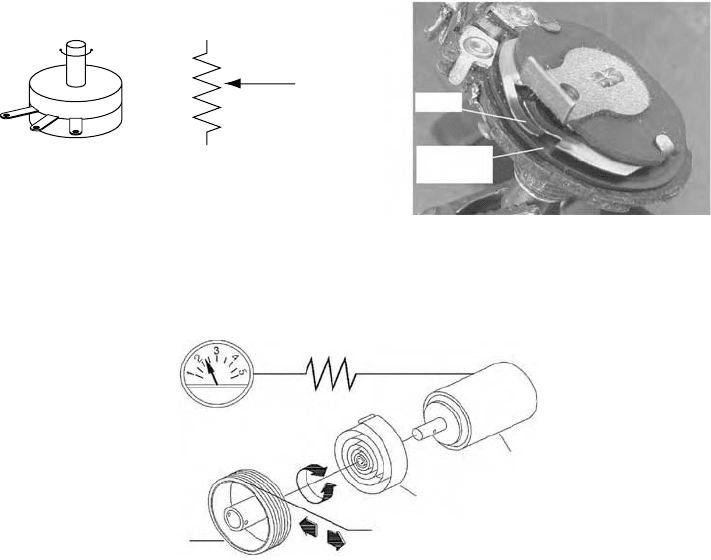
Sensors 20-7
20.1.3 Resistive
One of the simplest and least expensive ways to measure rotational or linear motion is using a variable
resistor called a potentiometer or rheostat. We focus on rotary potentiometers, or “pots” for short, but
the principle of operation is the same in the linear case.
A pot consists of three terminals (Figure 20.11a,b). Two end terminals, call them terminals 1 and 3,
connect to either end of a length of resistive material, such as partially conductive plastic, ceramic, or a
long thin wire. (For compactness, the long wire is wound around in loops to make a coil, leading to the
name wirewound potentiometer.)
The other terminal, terminal 2, is connected to a wiper, which slides over the material as the pot shaft
rotates. The total resistance of the pot R
13
is equal to the sum of the resistance R
12
between terminal 1
and the wiper, and the resistance R
23
between the wiper and terminal 3. Typically the wiper can rotate
from one end of the resistive material (R
13
= R
12
) to the other (R
13
= R
23
). If the full motion of the wiper
is caused by one revolution of the shaft or less, the pot is called a single-turn pot. If the full motion is
caused by multiple revolutions, it is called a multi-turn pot.
Typically a pot is used by connecting terminal 1 to a voltage V, terminal 3 to ground, and using the
voltage at the wiper as a measure of the rotation. The voltage observed at the wiper is V(R
23
/R
13
) and is
a linear function of the rotation of the shaft.
A remarkably simple absolute sensor for a wide range of distances is the string pot or draw-wire sensor
(Figure 20.12). It consists of a string wrapped on a spool, with a potentiometer to monitor rotations of the
spool. A return spring keeps the string taut. Lengths up to many meters may be measured, using sensors
incorporating multi-turn pots. The same technique is similarly useful for short distances (a few centimeters)
using compact single-turn pots and a small spool. Both tolerate misalignment or arc-like motion well.
String pots are susceptible to damage to the string in exposed applications, but the sensor element is small
and unobtrusive. Manufacturers include RDP Electronics, SpaceAge Control, and UniMeasure.
FIGURE 20.11 (a) As the shaft of the potentiometer rotates, the wiper moves from one end of the resistive material
to the other. (b) The inside of a typical potentiometer, showing the wiper contacting a resistive strip.
FIGURE 20.12 A string pot. (Courtesy of Space Age Control, Inc.)
wiper
1
2
3
1
2
3
(a)
Resistive
strip
Wiper
(b)
Aquisition, control,
or display device
Displacement cable
(attached to moving
object)
Rotary sensor
(in fixed position)
Internal spring
T
hreaded
drum
9258_C020.fm Page 7 Tuesday, October 9, 2007 9:08 PM
20-8 Mechatronic Systems, Sensors, and Actuators
Another type of resistive sensor is the flexible bend sensor. Conductive ink between two electrical
contacts on a flexible material changes resistance as the material bends and stretches. Used in a voltage
divider with a fixed resistor, the analog voltage may be used as a measure of the bend. Such a sensor
could be used to detect contact (like a whisker) or as a rough measure of the deformation of a surface
to which it is attached.
20.1.4 Tilt (Gravity)
A mercury switch can be used to provide one bit of information about orientation relative to the gravity
vector. A small drop of mercury enclosed in a glass bulb opens or closes the electrical connection between
two leads depending on the orientation of the sensor. Several mercury switches at different orientations
may be used to get a rough estimate of tilt. The signal from a mercury switch may “bounce” much like
the signal from a mechanical contact switch (Figure 20.2).
An inclinometer can be used to measure the amount of tilt. One example is the electrolytic tilt sensor.
Manufacturers include The Fredericks Company and Spectron Glass. Two-axis models have five parallel
rod-like electrodes in a sealed capsule, partially filled with a conductive liquid. Four of the electrodes are
at the corners of a square, with one in the middle. Tilting the sensor changes the distribution of current
injected via the center electrode in favor of the electrodes which are more deeply immersed.
Tilt sensors may be obtained with liquids of varying viscosity, to minimize sloshing. Because a DC
current through the liquid would cause electrolysis and eventually destroy the sensor, AC measurements
of conductivity are used. As a result, the support electronics are not trivial.
The liquid conductivity is highly temperature dependent. The support electronics for the tilt sensor
must rely on a ratio of conductivity between pairs of rods. Also, although the electrolytic tilt sensor
operates over a wide temperature range, it is greatly disturbed by nonuniformities of temperature across
the cell.
Another kind of simple inclinometer can be constructed from a rotary potentiometer with a pendulum
bob attached. A problem with this solution is that friction may stop the bob’s motion when it is not
vertical. A related idea is to use an absolute optical encoder with a pendulum bob. Complete sensors
operating on this principle can be purchased with advanced options, such as magnetic damping to reduce
overshoot and oscillation. An example is US Digital’s 12-bit A2I absolute inclinometer.
Of course, gravity acting on a device is indistinguishable from acceleration. If the steady-state tilt of
a device is the measurement of interest, simple signal conditioning should be used to ensure that the
readings have settled.
Other more sophisticated tilt sensors include gyroscopes and microelectromechanical (MEMS) devices,
which are not discussed here.
20.1.5 Capacitive
Capacitance can be used to measure proximity or linear motions on the order of millimeters. The
capacitance C of a parallel plate capacitor is given by C =
ε
r
ε
o
A/d, where
ε
r
is the relative permittivity
of the dielectric between the plates,
ε
o
is the permittivity of free space, A is the area of overlap of the two
plates, and d is the plate separation. As the plates translate in the direction normal to their planes, C is
a nonlinear function of the distance d. As the plates translate relative to each other in their planes, C is
a linear function of the area of overlap A. Used as proximity sensors, capacitive sensors can detect metallic
or nonmetallic objects, liquids, or any object with a dielectric constant greater than air.
One common sensing configuration has one plate of the capacitor inside a probe, sealed in an insulator.
The external target object forms the other plate of the capacitor, and it must be grounded to the proximity
sensor ground. As the sensor approaches the target, the capacitance increases, modifying the oscillation
of a detector circuit including the capacitor. This altered oscillation may be used to signal proximity or
to obtain a distance measurement.
Manufacturers of capacitive sensors include Cutler-Hammer and RDP Electronics.
9258_C020.fm Page 8 Tuesday, October 9, 2007 9:08 PM
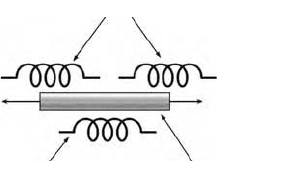
Sensors 20-9
20.1.6 AC Inductive
20.1.6.1 LVDT
The best known AC inductive sensor is the linear variable differential transformer, or LVDT. The LVDT is
a tube with a plunger, the displacement of the plunger being the variable to be measured (Figure 20.13).
The tube is wrapped with at least two coils, an excitation coil and a pickup coil. An AC current (typically
1 kHz) is passed through the excitation coil, and an AC signal is detected from the pickup coil and compared
in magnitude and in phase (0° or 180°) to the excitation current. Support electronics are needed for the
demodulation, which is called synchronous detection. The plunger carries a ferromagnetic slug, which
enhances the magnetic coupling from the excitation coil to the pickup coil. Depending on the position of
the slug within the pickup coil, the detected signal may be zero (when the ferrite slug is centered in the
pickup coil), or increasing in amplitude in one or the other phase, depending on displacement of the slug.
LVDTs are a highly evolved technology and can be very accurate, in some cases to the micron level.
They have displacement ranges of millimeters up to a meter. They do not tolerate misalignment or
nonlinear motion, as a string pot does.
20.1.6.2 Resolvers
A resolver provides a measure of shaft angle, typically with sine and cosine analog outputs. It uses an AC
magnetic technique similar to the LVDT, and similar support electronics to provide synchronous detec-
tion. Resolvers are very rugged and for this reason are often preferred over optical encoders on motor
shafts, although they are not as accurate and they have greater support electronics requirements. Some
resolver drives have extra outputs as if they were incremental encoders, for compatibility. Additionally,
resolvers provide an absolute measure of shaft angle. The resolver, like the LVDT, is a well established
and evolved technology.
20.1.7 DC Magnetic
A magnetic field acting on moving electrons (e.g., a current in a semiconductor) produces a sideways
force on the electrons, and this force can be detected as a voltage perpendicular to the current. The effect
is small, even in semiconductors, but has become the basis of a class of very rugged, inexpensive, and
versatile sensors.
20.1.7.1 Hall Effect Switches
Hall effect switches refers to devices which produce a binary output, depending on whether the magnetic
field intensity exceeds a threshold or not. In their component form, these switches may be packaged as
3-terminal devices the size of a transistor package (TO-92) or surface mount, having only a power lead
(3–24 V), a ground lead, and an output lead. Typically the output is pulled to ground, or not, depending
on the magnetic state. Hall effect switches are also available in environmental packages of all sorts.
The actuation threshold ranges from a few gauss (the Earth’s magnetic field is 1/2 G) up to the hundreds
of gauss levels typical of permanent magnets. Often there is a fair degree of unit-to-unit variability in threshold.
FIGURE 20.13 Operating principle of an LVDT.
Pickup coil
Excitation coil
Movable ferromagnetic slug
9258_C020.fm Page 9 Tuesday, October 9, 2007 9:08 PM
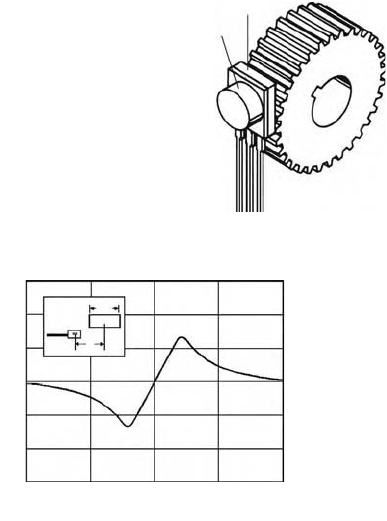
20-10 Mechatronic Systems, Sensors, and Actuators
Hall effect switches are hysteretic: their “turn-on” threshold may be different than the “turn-off ” threshold.
Sometimes hysteresis is used to make a switch latching, so that it stays in its last state (on or off) until the
applied magnetic field is reversed. Non-latching Hall switches may be unipolar (responding only to one
orientation of magnetic field) or bipolar (responding to a field of either polarity). Turn-on and turn-off
times are in microseconds.
Hall switches have wide operating temperature ranges and are often used in automobile engine
compartments. Another advantage is that they are not susceptible to most of the fouling mechanisms of
optical or mechanical switches, such as liquids or dirt. While often the moving part that is detected is a
magnet, it can also be arranged that a stationary “bias” magnet is intensified in its effect on the hall
switch by the approach of a ferrous part, such as a gear tooth, thus allowing nonmagnetized objects to
be detected (Figure 20.14).
Typical applications are the detection of a moving part, replacing a mechanical limit switch. The Hall
switch has no moving or exposed parts and is wear-free. Another common use is in indexing of rotational
or translational motion. The Hall switch is installed to detect one position, and its output pulse is used
as a reference for an incremental encoder which can count distance from that reference point. Hall
switches are inexpensive and small, so a number of them can be spaced at intervals of millimeters, forming
a low-resolution linear or rotational encoder or multi-position switch. Such an encoder or switch has
the ruggedness advantages of Hall switches.
20.1.7.2 Analog Hall Sensors
In a package the same small size as Hall switches, and costing little more, one can also get Hall devices
that have an analog output proportional to magnetic field strength (Figure 20.15). Typically, these have
full-scale magnetic field sensitivity in the 100 G range. These are not useful as a compass in the Earth’s
sub-gauss magnetic field.
Hall sensors are useful as linear or rotational encoders. Two Hall sensors may be arranged at right angles
to detect the sine and cosine of the angle of a rotating magnet, thus forming an absolute rotation sensor.
FIGURE 20.14 Detecting gear teeth in a ferrous mate-
rial using a Hall switch and a bias magnet. (Courtesy of
Allegro Microsystems, Inc.)
FIGURE 20.15
Output of an analog Hall sensor versus position relative to a magnet. (Courtesy of Allegro Microsystems, Inc.)
Bias magnet
N
Hall switch
Relative distance
–0.4 0.4
v
oq
v
cc
GND
–0.2
0
+
0.19
NS
D
–
0.20
Relative output voltage
Relative magnetic flux density
9258_C020.fm Page 10 Tuesday, October 9, 2007 9:08 PM
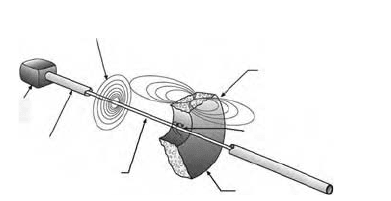
Sensors 20-11
Commercially available devices of this nature are called “Hall potentiometers” and have a variety of outputs
(e.g., sine and cosine, or a linear ramp repeating with each revolution). In contrast to potentiometers with
resistive strips and sliders, Hall pots allow continuous 360° rotation and experience no wear. All Hall effect
devices are susceptible to external magnetic fields, however.
Hall sensors are also excellent transducers of short linear or arc-like motions. The motion of a bar
magnet past a Hall sensor exposes the sensor to a magnetic field—which can be arranged to vary linearly
with displacement—over a range of several millimeters up to several centimeters. (The bar magnet travels
less than its own length.) Commercial implementations are known as throttle position sensors.
20.1.7.3 Tape-Based Sensors
There are a number of linear and rotational sensors, both incremental and absolute, which are similar
to optical encoders but use magnetic patterns rather than optical ones. Linear applications are likely to
require an exposed strip. In exposed applications, magnetic sensors have advantages in resistance to dirt,
although the magnetic stripes must be protected from damage.
20.1.8 Ultrasonic
Ultrasonic (US) sensors use the time-of-flight of a pulse of ultrasonic sound through air or liquid to
measure distance. Sensors are available with ranges from a few centimeters to 10 m. A great advantage of
US sensors is that all of the sensor’s electronic and transducer components are in one location, out of
harm’s way. The corresponding disadvantages are that US sensors tend to be indiscriminate: they may
detect spurious targets, even very small ones, especially if these are near the transducer. Sensors are available
with carefully shaped beams (down to 7°) to minimize detection of spurious targets. Some include
compensation for variation in air temperature, which affects sound velocity. US sensors can be used in
surprising geometries. For instance, they can be used to detect the liquid level in a vertical pipe; back-
reflection of sound pulses from the walls of a smooth pipe are minimal.
There is also an inexpensive and easily interfaced US sensor from Polaroid, derived from a ranging
device for an instant camera, which is popular with experimenters.
Ultrasonic sensors typically have an analog output proportional to distance to target. Accuracies of
the 1% level can be expected in a well-controlled environment.
20.1.9 Magnetostrictive Time-of-Flight
A more accurate technique for using time-of-flight to infer distance is the magnetostrictive wire transducer
(MTS). A moving magnet forms the “target” corresponding to the acoustic target in US sensors, and need
not touch the magnetrostrictive wire which is the heart of the device. The magnet’s field acting on the
magnetrostrictive wire creates an ultrasonic pulse in the wire when a current pulse is passed through
the wire. The time interval from the current pulse to the detection of the ultrasonic pulse at the end of the
wire is used to determine the position of the magnet along the wire (Figure 20.16).
FIGURE 20.16 Principle of operation of a magnetostrictive linear position sensor. (Courtesy of Temposonics, Inc.)
Interrogation pulse forms
magnetic field along entire
waveguide for 1 to 3 microseconds
Sensor
element
head
Magnetic field
from position magnet
Interaction of magnetic fields
launches torsional strain pulse
Position
magnet
Waveguide
Sensor element
Protective tube
9258_C020.fm Page 11 Tuesday, October 9, 2007 9:08 PM

20-12 Mechatronic Systems, Sensors, and Actuators
The magnetostrictive transducer does not have the inherent compactness and ruggedness of ultrasonic
through air, but does achieve similarly large measurement lengths, up to several meters. Accuracy and
stability are excellent, far better than ultrasonic. Some misalignment or nonlinear motion is tolerated,
because the target magnet does not need to be in very close proximity to the magnetostrictive wire.
20.1.10 Laser Interferometry
Laser interferometers are capable of measuring incremental linear motions with resolution on the order
of nanometers. In an interferometer, collimated laser light passes through a beam-splitter, sending the
light energy on two different paths. One path is directly reflected to the detector, such as an optical
sensing array, giving a flight path of fixed length. The other path reflects back to the detector from a
retroreflector (mirror) attached to the target to be measured. The two beams constructively or destruc-
tively interfere with each other at the detector, creating a pattern of light and dark fringes. The interference
pattern can be interpreted to find the phase relationship between the two beams, which depends on the
relative lengths of the two paths, and therefore the distance to the moving target. As the target moves,
the pattern repeats when the length of the variable path changes by the wavelength of the laser. Thus the
laser interferometer is inherently an incremental measuring device.
Laser interferometers are easily the most expensive sensors discussed in this chapter. They also
have the highest resolution. Laser interferometers are very sensitive to mechanical misalignment and
vibrations.
More information about sensors may be found in Sensors magazine (http://www.sensorsmag.com/).
References
1. Histand, M. B. and Alciatore, D. G., Introduction to Mechatronics and Measurement Systems, McGraw-
Hill, Boston, MA, 1999.
2. Bolton, W., Mechatronics, 2nd ed., Addison Wesley Longman, New York, NY, 1999.
3. Horowitz, P. and Hill, W., The Art of Electronics, 2nd ed., Cambridge University Press, Cambridge,
UK, 1998.
4. Auslander, D. M. and Kempf, C. J., Mechatronics: Mechanical System Interfacing, Prentice-Hall, Upper
Saddle River, NJ, 1996.
5. Jones, J. L., Flynn, A. M., and Seiger, B. A., Mobile Robots: Inspiration to Implementation, 2nd ed.,
A. K. Peters, Boston, MA, 1999.
20.2 Acceleration Sensors
Halit Eren
Acceleration relating to motion is an important section of kinematic quantities: position, velocity, accel-
eration, and jerk. Each one of these quantities has a linear relationship with the neighboring ones. That
is, all the kinematic quantities can be derived from a single quantity. For example, acceleration can be
obtained by differentiating the corresponding velocity or by integrating the jerk. Likewise, velocity can
be obtained by differentiating the position or by integrating the acceleration. In practice, only integration
is widely used since it provides better noise characteristics and attenuation.
There are two classes of acceleration measurements techniques: direct measurements by specific accel-
erometers and indirect measurements where velocity is differentiated. The applicability of these techniques
depends on the type of motion (rectilinear, angular, or curvilinear motion) or equilibrium centered
vibration. For rectilinear and curvilinear motions, the direct measurement accelerometers are preferred.
However, the angular acceleration is usually measured by indirect methods.
9258_C020.fm Page 12 Tuesday, October 9, 2007 9:08 PM

Sensors 20-13
Acceleration is an important parameter for general-purpose absolute motion measurements, vibration,
and shock sensing. For these measurements, accelerometers are commercially available in a wide range and
many different types to meet diverse application requirements, mainly in three areas: (1) Commercial
applications—automobiles, ships, appliances, sports and other hobbies; (2) Industrial applications—robotics,
machine control, vibration testing and instrumentation; and (3) High reliability applications—military,
space and aerospace, seismic monitoring, tilt, vibration and shock measurements.
Accelerometers have been in use for many years. Early accelerometers were mechanical types relying
on analog electronics. Although early accelerometers still find many applications, modern accelerometers
are essentially semiconductor devices within electronic chips integrated with the signal processing cir-
cuitry. Mechanical accelerometers detect the force imposed on a mass when acceleration occurs. A new
type of accelerometer, the thermal type, senses the position through heat transfer.
20.2.1 Overview of Accelerometer Types
A basic accelerometer consists of a mass that is free to move along a sensitive axis within a case. The
technology is largely based on this basic accelerometer and can be classified in a number of ways, such
as mechanical or electrical, active or passive, deflection or null-balance accelerometers, etc. The majority
of industrial accelerometers are classified as either deflection or null-balance types. Accelerometers used
in vibration and shock measurements are usually the deflection types, whereas those used for the mea-
surement of motions of vehicles, aircraft, and so on for navigation purposes may be either deflection or
null-balance type.
This article will concentrate on the direct measurements of acceleration, which can be achieved by the
accelerometers of the following types:
•
Inertial and mechanical
•
Electromechanical
•
Piezoelectric
•
Piezoresistive
•
Strain gauges
•
Capacitive and electrostatic force balance
•
Micro- and nanoaccelerometers
Depending on the principles of operations, these accelerometers have their own subclasses.
20.2.2 Dynamics and Characteristics of Accelerometers
Acceleration is related to motion, a vector quantity, exhibiting a direction as well as magnitude. The
direction of motion is described in terms of some arbitrary Cartesian or orthogonal coordinate systems.
Typical rectilinear, angular, and curvilinear motions are illustrated in Figures 20.17a–c, respectively.
FIGURE 20.17 Types of motions to which accelerometers are commonly applied.
x
y
z
Pat
M
x
y
z
θ
θ
Pat
M
x
y
+s
M
−s
Pat
z
(a)
(b)
(c)
9258_C020.fm Page 13 Tuesday, October 9, 2007 9:08 PM
